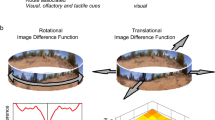Abstract
The visual apprehension of three-dimensional space both in animals and machines uses flat (two-dimensional) images or views as one major source of information. It is often assumed that visually guided behaviour in the 3D world relies on 3D models that are constructed from the images. In this paper, it is argued that such models are not necessary for a number of spatial tasks including obstacle avoidance and maze exploration. An analysis of the minimal amount of information required to perform these tasks shows that view-based processing suffices. The results are related to current models of rotation invariant object recognition that also suggest view-based processing.
Access this chapter
Tax calculation will be finalised at checkout
Purchases are for personal use only
Preview
Unable to display preview. Download preview PDF.
Similar content being viewed by others
References
Arndt, P.A., H.A. Mallot, & H.H. Bülthoff (1995). Human Stereovision without localized image-features. Biological Cybernetics 72, 279–293.
Braitenberg, V. (1984). Vehicles. Experiments in synthetic psychology. Cambridge, MA: MIT Press.
Bülthoff, H.H., & S. Edelman (1992). Psychophysical support for a two-dimensional view interpolation theory of object recognition. Proceedings of the National Academy of Sciences, USA, 89, 60–64.
Cartwright, B.A., & T.S. Collett (1982). How honey bees use landmarks to guide their return to a food source. Nature 295, 560–564.
Collett, T. (1992). Landmark learning and guidance in insects. Philosophical Transactions of the Royal Society (London) B 337, 295–303.
Edelman, S. & D. Weinshall (1991). A self-organizing multiple-view representation of 3D objects. Biological Cybernetics 64, 209–219.
Franz, M.O., B. Schölkopf, H.A. Mallot, & H.H. Bülthoff (1998a). Learning view graphs for robot navigation. Autonomous Robots 5, 111–125.
Franz, M.O., B. Schölkopf, H.A. Mallot, & H.H. Bülthoff (1998b). Where did I take this snapshot? Scene-based homing by image matching. Biological Cybernetics 79, 191–202.
Gallistel, C.R. (1990). The organization of learning. Cambridge, MA: MIT Press.
Gillner, S., & H.A. Mallot (1998). Navigation and acquisition of spatial knowledge in a virtual maze. To appear in: Journal of Cognitive Neuroscience 10, 445–463.
Kohonen, T. (1982). Self-organized formation of topologically correct feature maps. Biological Cybernetics 43, 59–69.
Kosecka, J., H.I. Christensen, & R. Bajcsy (1995). Discrete event modeling of visually guided behaviors. International journal of Computer Vision 14, 179–191.
Kuipers, B.J., & Y.-T. Byun (1991). A robot exploration and mapping strategy based on a semantic hierarchy of spatial representations. Journal of Robotics and Autonomous Systems 8, 47–63.
Mallot, H.A. (1997). Behavior-oriented approaches to cognition: Theoretical perspectives. Theory in Biosciences 116, 116–220.
Mallot, H.A. (1997). Spatial scale in stereo and shape-from-shading: Image input, mechanisms, and tasks. Perception 26, 1137–1146.
Mallot, H.A., H.H. Bülthoff, P. Georg, B. Schölkopf, & K. Yasuhara (1995). View-based cognitive map learning by an autonomous robot. Proceedings of the International Conference on Artificial Neural Networks (ICANN) ′95 and Neuronîmes ′95, volume II (pp. 381–386). Paris: EC2 & Cie.
Mallot, H.A., H.H. Bülthoff, J.J. Little, & S. Bohrer (1991). Inverse perspective mapping simplifies optical flow computation and obstacle detection. Biological Cybernetic 64, 177–185.
Mallot, H.A., & S. Gillner (1997). Psychophysical support for a view-based strategy in navigation. Investigative Ophthalmology and Visual Science 38(Suppl.), 4683. ARVO-Abstract No. 4683.
Mallot, H.A., & N.K. Logothetis (1998). Mechanisms of cognition (introductory remarks). In N. Eisner & R. Wehner (eds.), New neuroethology on the move, volume 1 (pp. 278–283). 26th Göttingen Neurobiology Conference. Stuttgart, Germany: Thieme Verlag.
Mallot, H.A., E. Schulze, & K. Storjohann (1989). Neural network strategies for robot navigation. In L. Personnaz & G. Dreyfus (eds.), Neural networks from models to applications (pp. 560–569). Paris: I.D.S.E.T.
Marr, D. (1982). Vision. San Francisco, CA: W.H. Freeman.
Martinetz, T.M., & K. Schulten (1994). Topology representing networks. Neural Networks 7, 507–522.
Mayhew, J.E.W., Y. Zheng, & S. Cornell (1992). The adative control of a four-degrees-of-freedom stereo camera head. Proceedings of the Royal Society London B 337, 315–326.
McNaughton, B.L., C.A. Barnes, & J. O’Keefe (1983). The contributions of position, direction, and velocity to single unit activity in the hippocampus of freely moving rats. Experimental Brain Research 52, 41–49.
O’Keefe, J., & L. Nadel (1978). The hippocampus as a cognitive map. Oxford, England: Clarendon.
Schölkopf, B., & H.A. Mallot (1995). View-based cognitive mapping and path planning. Adaptive Behavior 3, 311–348.
von Seelen, W., S. Bohrer, J. Kopecz, & W.M. Theimer (1995). A neural architecture for visual information processing. Internationaljournal of Computer Vision 16, 229–260.
Trullier, O., S.I. Wiener, A. Berthoz, & J.-A. Meyer (1997). Biologically based artificial navigation systems: Review and prospects. Progress in Neurobiology 51, 483–544.
Wagner, K. (1970). Graphentheorie. Mannheim, Wien, Zürich: Bibliographisches Institut.
Author information
Authors and Affiliations
Editor information
Editors and Affiliations
Rights and permissions
Copyright information
© 2000 Springer Science+Business Media Dordrecht
About this chapter
Cite this chapter
Mallot, H.A. (2000). View-Based Navigation: Obstacle Avoidance and Maze Exploration. In: Cruse, H., Dean, J., Ritter, H. (eds) Prerational Intelligence: Adaptive Behavior and Intelligent Systems Without Symbols and Logic, Volume 1, Volume 2 Prerational Intelligence: Interdisciplinary Perspectives on the Behavior of Natural and Artificial Systems, Volume 3. Studies in Cognitive Systems, vol 26. Springer, Dordrecht. https://doi.org/10.1007/978-94-010-0870-9_54
Download citation
DOI: https://doi.org/10.1007/978-94-010-0870-9_54
Publisher Name: Springer, Dordrecht
Print ISBN: 978-94-010-3792-1
Online ISBN: 978-94-010-0870-9
eBook Packages: Springer Book Archive




